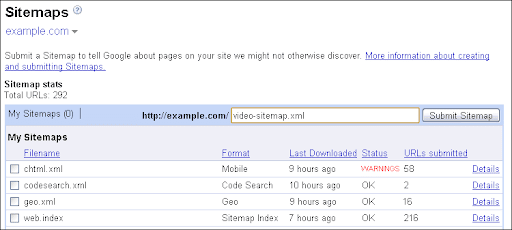Thursday, December 18, 2008
Submitting a Sitemap to Google just became even easier. No longer do you have to specify the Sitemap file type—we'll determine the type of data you're submitting automatically. Let's take a quick look at the kinds of Sitemap files we support as well as the ways they can be submitted to us.

Sitemap file formats supported by Google
Part of what makes the web so interesting is that there are so many different kinds of content out there. Do you use videos on your website? If so, send us a Video Sitemap file so that we can send you visitors to those videos! Do you host source-code samples? Submit a Code Search Sitemap! Here are the various kinds of Sitemap files that Google supports at the moment:
- XML Sitemap files for web pages —Use these files to submit all of your web pages (this is the preferred format for web pages). While not all search engines may support the Sitemap types listed below, the XML Sitemap for web pages is supported by all search engines of sitemaps.org .
- RSS 2.0 and Atom 1.0 feeds for web pages—Many blogs create these automatically.
- Text files with web page URLs —If you can't automatically create one of the above formats, you can create a text file with your URLs in it.
- XML Sitemap files for Video Search —Videos on your website can be indexed and made available for Google Video Search.
- Media-RSS feeds for Video Search—mRSS feeds are used by various other systems, we can use these for Google Video Search as well.
- XML Sitemap files for Google Code Search —If you make programming samples or code available to your users, you can submit these for Google Code Search .
- XML Sitemap files for mobile web pages —Using this kind of format allows us to recognize content that has been optimized for mobile devices (please note that there was recently a small change in the format).
- XML Sitemap files for geo-data —If you have geographic data on your website in the form of KML or GeoRSS files, please let us know about these files.
- XML Sitemap files for News —News websites can submit their news content in this special Sitemap format (please note that you must first register with Google News before these files are processed).
If you have multiple Sitemap files that you wish to submit to Google, you can include up to 1,000 of these in an XML Sitemap Index file . If you have more than 1,000 Sitemap files, you can just submit multiple Sitemap Index files—we'd love to take them all!
Submitting your Sitemap files to Google
Once you have your Sitemap files ready and available on your server, all that's left is making sure that the search engines can find them. Google supports three simple ways to submit Sitemap files:
-
Using Google Webmaster Tools —Submitting your Sitemap files through Google Webmaster Tools is the preferred way of letting us know about them. The main advantage of doing it this way is that you'll always have direct feedback about how your Sitemap files were downloaded (were we able to reach your server?), how they were recognized (were they in the right format?) and what happened to the web pages listed in them (how many were indexed?). To submit your Sitemap files, make sure that your website is verified in Webmaster Tools , then go to "Sitemaps" in Webmaster Tools and enter the file name of your Sitemap(s).
Sometimes it makes sense to keep your Sitemap file on a different server / domain name. To submit Sitemap files like that, you must verify ownership of both sites in Webmaster Tools and submit the Sitemap on the appropriate site. For instance, if your Sitemap file for
https://www.example.comis kept onhttps://sitemap-files.example.com/then you need to verify ownership of both sites and then submit the Sitemap file underhttps://sitemap-files.example.com(even though the URLs listed in it are forhttps://www.example.com). For more information, please see our Help Center topic on submitting Sitemap files for multiple sites . - Listing Sitemap files in the robots.txt file—Another way of submitting a Sitemap file is to specify the URL in your robots.txt file . If you use this method of submitting a Sitemap file, it will be found by all search engines that support the Sitemaps protocol (although not all of them support the extensions listed above). Since you can specify the full URL of your Sitemap file in the robots.txt file, this method also allows you to store your Sitemap file on a different domain. Keep in mind that while Sitemap files submitted this way are processed on our side, they will not be automatically listed in your Webmaster Tools account. In order to receive feedback on your files, we recommend adding them manually to your account as well.
-
Using an HTTP "ping" —If your Sitemap files are generated automatically, a convenient way to submit (and re-submit) them is to access the "ping" URL for Google Sitemaps. This URL includes the URL of your Sitemap file. For more information on the "ping" URL for your website, please see the Help Center article on Updating a Sitemap . You can "ping" this URL whenever you update your Sitemap file—we'll know to pick it up and process it again. If you also have your Sitemap file registered in Webmaster Tools, we'll update the status there as well. This method is also valid if your Sitemap file is kept on a different server, but you must still verify both sites in Webmaster Tools as previously mentioned.
Search engines that are a members of sitemaps.org support a similar way of submitting general web Sitemap files.
We hope these simplifications make it even easier for you to send us your Sitemap files!


